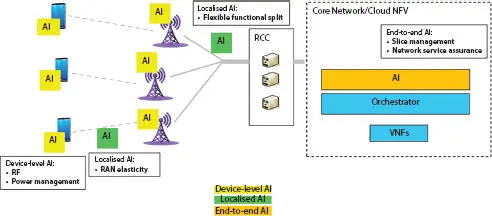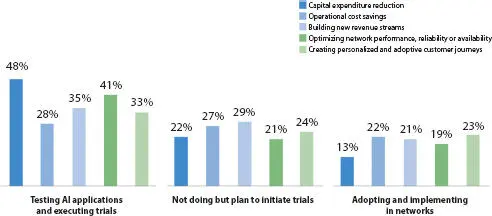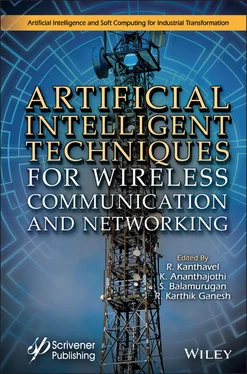Artificial Intelligent Techniques for Wireless Communication and Networking
Здесь есть возможность читать онлайн «Artificial Intelligent Techniques for Wireless Communication and Networking» — ознакомительный отрывок электронной книги совершенно бесплатно, а после прочтения отрывка купить полную версию. В некоторых случаях можно слушать аудио, скачать через торрент в формате fb2 и присутствует краткое содержание. Жанр: unrecognised, на английском языке. Описание произведения, (предисловие) а так же отзывы посетителей доступны на портале библиотеки ЛибКат.
- Название:Artificial Intelligent Techniques for Wireless Communication and Networking
- Автор:
- Жанр:
- Год:неизвестен
- ISBN:нет данных
- Рейтинг книги:5 / 5. Голосов: 1
-
Избранное:Добавить в избранное
- Отзывы:
-
Ваша оценка:
- 100
- 1
- 2
- 3
- 4
- 5
Artificial Intelligent Techniques for Wireless Communication and Networking: краткое содержание, описание и аннотация
Предлагаем к чтению аннотацию, описание, краткое содержание или предисловие (зависит от того, что написал сам автор книги «Artificial Intelligent Techniques for Wireless Communication and Networking»). Если вы не нашли необходимую информацию о книге — напишите в комментариях, мы постараемся отыскать её.
The 20 chapters address AI principles and techniques used in wireless communication and networking and outline their benefit, function, and future role in the field.
Audience
Artificial Intelligent Techniques for Wireless Communication and Networking — читать онлайн ознакомительный отрывок
Ниже представлен текст книги, разбитый по страницам. Система сохранения места последней прочитанной страницы, позволяет с удобством читать онлайн бесплатно книгу «Artificial Intelligent Techniques for Wireless Communication and Networking», без необходимости каждый раз заново искать на чём Вы остановились. Поставьте закладку, и сможете в любой момент перейти на страницу, на которой закончили чтение.
Интервал:
Закладка:
2.2 Integrated Services of AI in 5G and 5G in AI
5G would be able and stronger than the conditions characteristic to host many more smart devices, particularly when about 41.6 billion Internets of Things smart devices are to be used by 2025. This is especially critical and many want a secure cloud access for efficient movement, such as driverless car systems and industrial sensors [12].
GSMA, the mobile network trading body, has identified wireless technology as providing three pillars of next-generation connectivity:
enhanced mobile broadband (eMBB),
ultra-reliable,
low-latency communications (URLLC) and massive machine-type communications (mMTC).

Figure 2.3AI in next generation networks.
Multiple devices based on high-speed and low-speed bandwide will be needed for the supporting equipment, both require online analytics in real-time. The large number of information generated requires the combination of 5G and Artificial Intelligence (AI) (Figure 2.3) [6].
2.2.1 5G Services in AI
AI can exist at every angle in the cloud environments, multi clouds, and mobile network of the potential. We also see significant suppliers of Technological innovations, such as NVIDIA, making significant contributions in 5G-based networks in connectivity, the Internet of Things (IoT) and other edge environments [14, 20].
2.2.1.1 Next-Generation Edge Convergence With AI Systems on Chip
5G is compatible with the wireless Long-Term Growth and Wi-Fi interfaces cellular networks. 5G can quickly extend through indoor and large areas when introduced in cross-technology access points. Ultimately, the implementation of technology will lead to radio spectrum convergence for these various radio channels and the development of single chip access points, which are easily accessible to seamless connectivity through various radio access technologies. For many mass device realms with neural network processing cycle, all this 5G interfaces will eventually turn into low-power low-cost chip systems (Figure 2.4).
2.2.1.2 Massive Device Concurrency Replenishing AI Data Lakes in Real Time
5G can handle up to one million competing boundary devices per square kilometer, which is larger than 4G networks in a magnitude order. The last scale would enable companies, in a shifting paradigm known as multiaccess leading computing, to regularly obtain large amounts of data from cellphones, sensors, heating systems and other mobile devices. As 5G networks start to overwhelm water data structures with new telephone data globally, AI application analysts and data scientists can create more advanced analytical data.
2.2.1.3 Ultra-Fast, High-Volume Streaming for Low-Latency AI
5G connection times are substantially less as 4G, as small as 1 ms vs. the 50 ms 4G feature. As a result, 5G has far higher transmissions and processing rates than 4G, which is 20 Gb/s or 5–12 Mb/s for 4G. The stronger relation between the bandwidth of the system and the 5G power amplifier comes from the capacity to simultaneously transmit several data streams between the ground station and the borders. These fun working methods allow 5G to serve AI DevOps pipelines staff in low latency, from data intake, planning, modeling, training in real-time streaming scenarios. In addition, when coupled with its much lower latency, the faster download speeds of 5G will allow analysts to obtain, clean and evaluate much more information in a much shorter period of time.
2.2.2 AI Services in 5G
2.2.2.1 Distributed AI
AI is also a major aspect of the network that guarantees that AI and other software staffing levels can be accommodated with all their difficulty by 5G networks. New research shows that many providers of telecommunications are well on track to launch AI in order to operate 5G networks worldwide. 5G network will have to be self-regulating, self-sustaining, self-repairing and continuing self-optimizing in order to best support the next wave of decentralized AI applications. The key goal is to automate application-level net traffic, quality-of-service management, process development, analysis, and other associated processes more flexible, reliable, easily, and efficiently than conventional procedures. In addition, computer training and other AI frameworks may be implemented.

Figure 2.4Service providers achieving benefits through AI.
2.2.2.2 AI for IT Operations (AIOps)
To ensure that 5G provides much faster, safer and more RF-efficient connectivity than before, AIOps will be necessary. For the virtual machines in the network and multi-cloud management suites which tackle 5G networks and applications from one end to the next, AIOps technologies will have to be central. At least from the end-to-end through 5G ecosystems, AIOps drives consistent quality of service. AI-based controls can ensure continuous and accurate configuration of RF channels and other network infrastructures to support improvements in service quality, traffic patterns, and application tasks. They also encourage reliable alarm control, installation and healing and the optimization of the subscriber’s interface.
2.2.2.3 Network Slicing
A 5G networking feature known as network slicing will be augmented by AIOps tooling. This allows many virtual networks to be run over one physical connection by 5G networks. AIOps tooling will allow proactive and dynamic supply of individual wireless service quality levels for many customer categories and edge device groups by using this virtualized resource allocation capacity. AIOps will also be required to increase dynamic 5G RF-channel allocation.
5G has smaller cells than 4G at each edge unit, reuses wavelengths more thoroughly, and must re-target “beam formed” base station phase-array millimeter-wave antennas continuously. In order to secure service quality, 5G base stations instantly predict as well as provide each user with the best wireless router. They do this because the problems associated with 5G mm waves moving through walls and other hard surface areas are constantly being tackled. In order to perform these measurements in real time over constantly evolving local wireless loops, a securely shuttered real-time analysis is necessary.
All this AI inside the 5G network, for example, would have a support system for data storage. We would expect to see regularly develop in 5G networks specialist data lakes, autoML applications, DevOps databases and other critical operational architectures to ensure that the best AI models are implemented in real time. This data/model governance will be introduced through cloud-to-edge architectures that fit into complex public/private federal environments typical of 5G [17, 21].
2.2.3 Evolution With AI in the 5G Era
2.2.3.1 Agile Network Construction
AI is extended to each level of 5G network creation in order to make network preparation more accurate and the implementation more successful. Various data points from major regions, the 5G industry, users and the advancement of today’s technology are used for machine learning and incremental computing to rapidly and reliably construct plans for different scenarios. In the processes of survey, layout, overseeing, integration and adoption, innovations such as image processing, optical character recognition (OCR), speech recognition.
Читать дальшеИнтервал:
Закладка:
Похожие книги на «Artificial Intelligent Techniques for Wireless Communication and Networking»
Представляем Вашему вниманию похожие книги на «Artificial Intelligent Techniques for Wireless Communication and Networking» списком для выбора. Мы отобрали схожую по названию и смыслу литературу в надежде предоставить читателям больше вариантов отыскать новые, интересные, ещё непрочитанные произведения.
Обсуждение, отзывы о книге «Artificial Intelligent Techniques for Wireless Communication and Networking» и просто собственные мнения читателей. Оставьте ваши комментарии, напишите, что Вы думаете о произведении, его смысле или главных героях. Укажите что конкретно понравилось, а что нет, и почему Вы так считаете.












